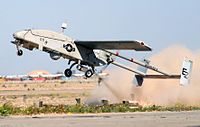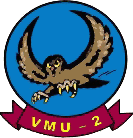| Marine Unmanned Aerial Vehicle Squadron 2 | |
|---|---|
 VMU-2 insignia | |
| Active | June 1984 - present |
| Country | United States |
| Branch | USMC |
| Type | Aerial reconnaissance |
| Role | Reconnaissance, Surveillance and Target Acquisition |
| Size | Squadron |
| Part of |
Marine Aircraft Group 14 2nd Marine Aircraft Wing |
| Garrison/HQ | Marine Corps Air Station Cherry Point |
| Nickname(s) | "Night Owls" |
| Engagements |
Operation Desert Storm Operation Iraqi Freedom Operation Enduring Freedom |
| Commanders | |
| Current commander | LtCol Anthony C. Bolden |
Marine Unmanned Aerial Vehicle Squadron 2 (VMU-2) is an unmanned aerial vehicle squadron in the United States Marine Corps that operates the RQ-7 Shadow. They are based at Marine Corps Air Station Cherry Point, North Carolina and provide aerial surveillance for the II Marine Expeditionary Force. They fall under the command of Marine Aircraft Group 14 and the 2nd Marine Aircraft Wing.
History[]
Early years[]
VMU-2 was originally formed in June 1984 as Detachment T, Target Acquisition Battery, 10th Marine Regiment, 2nd Marine Division, Fleet Marine Forces, Atlantic, thus becoming the first Remotely Piloted Vehicle (RPV) unit within the Marine Corps.
On August 22, 1984, the detachment reorganized, and was re-designated, as the 1st Remotely Piloted Vehicle Platoon, Headquarters Battalion, and 2nd Marine Division. During November 1984, Marines traveled to Israel and began indoctrination training on the Mastiff RPV system. Upon completion of contractor training, 1st RPV Platoon accepted its first two Mastiff air vehicles, control stations, and associated ground support equipment.

VMU-2 UAV — Pioneer Short Range (SR) UAV
In June 1986, 1st RPV Platoon was assigned to the 13th Marine Amphibious Unit and embarked aboard USS Tarawa for operations in the Western Pacific. In October 1986, the 1st RPV Platoon was reorganized and re-designated as the 2nd Remotely Piloted Vehicle Company, Headquarters Battalion, 2nd Marine Division at Camp Lejeune, NC while deployed with the 13th MAU. The 2d RPV Company transitioned to the Pioneer (Option I) Unmanned Aerial Vehicle system. During May 1987, 2d RPV Company was awarded the Navy Unit Commendation for its numerous contributions to the fielding of Unmanned Aerial Vehicles within the Marine Corps.
During the next three years, the 2d RPV Company trained on the Pioneer system and deployed within the continental United States in support of several Marine Corps exercises. In February 1989, RPVs were incorporated into the Surveillance, Reconnaissance, Intelligence Group (SRIG) concept as an independent company under the group command in March 1990; the unit received the Pioneer Option II air vehicle. As the first UAV unit to field this upgrade, the company embarked aboard the USS Nassau and conducted the first shipboard trial operations of the Pioneer Option II air vehicle.
Gulf War and 1990s[]

The old VMU-2 insignia
In August 1990, the 2d RPV Company was reassigned to the 4th Marine Expeditionary Brigade (4th MEB) and embarked to Southwest Asia in support of Operation Desert Shield. The company remained embarked with the 4th MEB until November 1990. Thereafter, the company was ordered ashore and reassigned to the 1st Surveillance, Reconnaissance and Intelligence Group, I Marine Expeditionary Force. During January 1991, the company deployed to Saudi Arabia in direct support of the 2nd Marine Division and later conducted missions in support of Operation Desert Storm. From February 15, to March 3, 1991, direct support of Operation Desert Storm was conducted from Al Qurah. 2d RPV Company began retrograde operations and returned to Camp Lejeune on 20 March 1991. During Operation Desert Shield/Storm, 2d RPV Company flew a total of 69 sorties and 226 flight hours. Of these, 55 sorties and 192 flight hours were combat. No Pioneer air vehicles were lost as a result of enemy action.
During May 1991, a detachment from 2d RPV Company was formed to participate in Operation Provide Comfort and the Kurdish relief effort in northern Iraq. These Marines provided surveillance information during the conduct of the operation. The detachment returned to Camp Lejeune, NC on 31 May 1991. For the remainder of 1991, the company provided support to various elements of II Marine Expeditionary Force.
On January 1, 1993, 2d Remotely Piloted Vehicle Company was re-designated as the 2d Unmanned Aerial Vehicle (UAV) Company and in February 1994, the company was re-equipped with the Pioneer Option II Plus air vehicle. On January 16, 1996, 2nd UAV Company was reorganized under Marine Aviation sponsorship and re-designated as Marine Unmanned Aerial Vehicle Squadron 2 (VMU 2). Placed under Marine Aircraft Group 14, 2nd Marine Aircraft Wing, the squadron was relocated to Marine Corps Air Station Cherry Point, NC in May 1996. Then, in August 2000, VMU-2 was re-assigned to Marine Air Control Group 28, 2nd Marine Aircraft Wing.
As of May 13, 2013 VMU-2 was re-assigned to Marine Aircraft Group 14.
Global War on Terrorism[]
VMU-2 deployed to Kuwait in February 2003 and subsequently played a key role in Operation Southern Watch and Operation Iraqi Freedom. Conducting day and night aerial reconnaissance, surveillance, and target acquisition missions in support of coalition forces in the Persian Gulf region, the squadron was deployed for seven months in support of combat operations. Of the 30 squadrons, 200 aircraft and more than 7000 Marines and Sailors from 2nd MAW to conduct combat operations in Iraq, VMU-2 was the final unit to return from Iraq in September 2003.
In February 2004, the squadron deployed to Al Taqqadum Airbase, Iraq again in support of Operation Iraqi Freedom conducting combat missions in support of coalition forces in the Sunni Triangle region. During this deployment the Squadron flew over 2,100 hours comprising 700+ combat sorties in support of I MEF in and around Fallujah and Ramadi, Iraq. In August 2004 the Squadron returned to MCAS Cherry Point and are currently preparing for yet another deployment to Iraq.
VMU-2 has deployed four more times in 2005, 2006, 2007 and 2008. The squadron will deploy a detachment to Afghanistan in the spring of 2009 as part of the 2nd Marine Expeditionary Brigade.[1] They will be part of the 17,000 troop increase announced by President Obama in mid-February.[2]
See also[]
- United States Marine Corps Aviation
- History of unmanned aerial vehicles
- List of active United States Marine Corps aircraft squadrons
- List of inactive United States Marine Corps aircraft squadrons
Notes[]
- ↑ Hlad, Jennifer (2008-03-09). "2/8, other Lejeune units to deploy with 2nd MEB". www.enctoday.com. http://www.enctoday.com/news/2nd_62892_jdn__article.html/meb_expeditionary.html. Retrieved 2009-03-09.
- ↑ Page, Susan (2009-02-16). "Obama OKs adding Afghanistan forces". USA Today. http://www.usatoday.com/news/world/2009-02-17-afghanistan-forces_N.htm?csp=34. Retrieved May 27, 2010.
References[]
This article incorporates public domain material from websites or documents of the United States Marine Corps.
- Bibliography
- Web
| ||||||||||||||||||||||||||
| |||||||||||||||||||||||
The original article can be found at VMU-2 and the edit history here.

